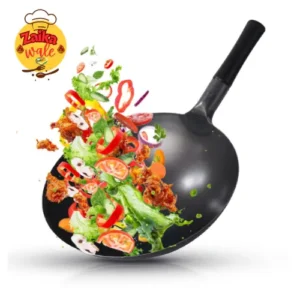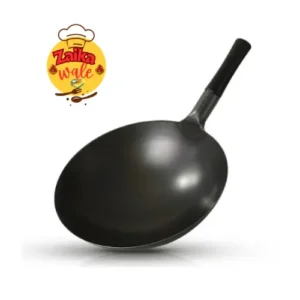Table of Contents
ToggleHakka Noodles Recipe
Everyone’s favorite is these restaurant-style Hakka Noodles. Stir-fried noodles with veggies and sauces is a well-known Indo-Chinese meal. In Indian restaurants, veggie Hakka noodles are among the most well-liked meals.However, did you know that it’s really easy to make them at home?
I demonstrate how to create the ideal Indian-Chinese Hakka Noodles in this post. They are flavorful, delicious, and have a wonderful crunch in every bite. Make it vegetarian or add your preferred protein, such as tofu, eggs, or beef (details are in the post).
The Chinese community in Kolkata, India, is credited with creating Indo-Chinese Hakka noodles. Many Indians have learned to love it over the years. From the luxurious restaurants to the street trucks, these are some of the most popular. Sadly, the majority of these establishments serve noodles that are so high in fat and sodium that they severely dehydrate us. Therefore, why not prepare these at home?
About Hakka Noodles
The Indian-Chinese noodles known as Hakka are made using unleavened refined wheat flour.
After being boiled al dente, these are stir-fried with oil, veggies, and soy sauce in a Chinese wok. In this context, “hakka noodles” refers to both the finished dish and the kind of noodles utilized.
Hakka noodles are sold by numerous brands. You might purchase a product from a reputable brand that you like. You can use any brand of egg noodles, but I used Ching’s vegetarian Hakka noodles.
I try to keep these to a minimum because they are produced with refined flour. You can use any other whole grain noodles, such as udon, ramen, or soba noodles, if you’re attempting to stay away from refined foods.
Soba noodles are extremely thin and made with buckwheat. I frequently cook my vegetarian noodles using them. Despite being produced with whole wheat, udon noodles are thick and fat. Some extremely thin noodles are made from wheat flour. I’ve included them into this chili garlic noodle recipe.
You can still use these if you want to eat healthily, which is something I frequently do, even though they aren’t utilized in the recipes for real Hakka noodles.
My Recipe
The Hakka Noodles served in restaurants are really simple and contain very little vinegar and soy sauce. The wok hei, a unique smoky aroma that results from stir-frying the ingredients over an open flame on high heat, is mostly responsible for the dish’s flavor.
For a taste boost, most eateries employ MSG or aromat powder. But I haven’t used MSG in this recipe and have never found the necessity because the dish still tastes great without it. Therefore, it is crucial to concentrate on four elements in order to imitate the restaurant flavors:
Using a wok, stir-fry over high heat.
- The noodles should be just al dente; avoid overcooking them.
- Julienne the vegetables long and thin to match the noodles in size. It takes practice to get flawless.
- Avoid using too many condiments to enhance the smokey flavor. But if you want saucy noodles, you may create street-style hakka noodles with chili garlic sauce. If you don’t have any spicy sauce, feel free to use any other.
What to serve with Hakka Noodles
- These noodles are so flavorful that you can eat them by yourselves. Still, Hakka noodles are usually served with a side of chili or Manchurian cuisine, including Green Manchurian or Gobi Manchurian, at restaurants.
Chili Paneer Manchurian Paneer
Chicken Manchurian with Chili.
Ingredients & Substitutes
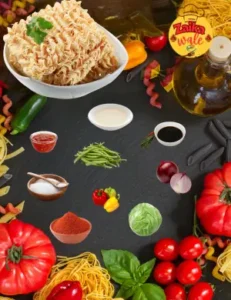
- Vegetables: Regular onions, bell peppers, carrots, spring onions or scallions, French beans, and cabbage are the most common ingredients for this recipe. Anything you have can be used. I always think that adding cabbage to Hakka noodles gives them a wonderful crisp and scent. But since I didn’t have it, I haven’t used it this time.
- Oil: Make use of oils with a high smoke point, such as sunflower, safflower, or peanut oil. After stir-frying, upscale restaurants finish by adding a little toasted sesame oil to bring out the flavors. But avoid using toasted sesame oil while stir-frying hakka noodles as it may leave a bitter aftertaste. This kind of oil is used for salads and dressings, not for frying.
- Soya sauce: Select organic or organically made soy sauce. Steer clear of other types of soy because they are created with harsh chemicals and don’t have the same depth of flavor. You can substitute tamari for soy sauce.
- Vinegar: Vinegar: White vinegar or rice vinegar are used to make Hakka noodles.However, apple cider can also be used. Steer clear of artificial vinegar.
- Spices: Three spices—garlic, ginger, and crushed pepper—are used. Although they don’t taste spicy, these spices give the noodles a pleasant scent. Ginger isn’t used in my recipe. Because it is less fiery and strong, white crushed pepper is typically utilized. I don’t stock up on white pepper, so I use black ground pepper.
- Chilies: Most of Indo-Chinese restaurants exclusively use rice vinegar and soy sauce. Either the chili oil or the green chilies provide the heat. If you enjoy hot, spicy noodles, you are free to use any hot sauce. I also regularly whip up my best homemade Schezwan sauce.
- Chilli oil You can use chilli oil if you have it, but it is not essential. Some restaurants add it to their food to improve the flavor. Various types of chili oil prepared from red chilies, Schezwan peppers, garlic, and other ingredients are sold in the market. What you enjoy is up to you to decide. I haven’t used any here.
Recipe for Hakka Noodles (step-by-step pictures)
Prepare the following ingredients:
- ½ tablespoon finely chopped ginger (optional; peel beforehand) • 1 tablespoon finely minced garlic from 2 to 3 cloves
- Chop two to three green onions or spring onions, then separate the whites from the greens.
- To make half a cup (50 grams), slice one tiny yellow or red onion.
- Chop one green chili (deseed for reduced heat, if desired).
Peel and julienne one small carrot (50 grams, or ½ cup). - 80 grams, or ½ to ¾ cup, of Julienne capsicum (the green, yellow, or red bell pepper variety)
- Finely chop six green or French beans, if desired.
- Finely shred the cabbage to create 60 grams, or ½ cup; I didn’t use it.
In a big pot, bring 8 cups water to a rolling boil. Cook one bag of hakka noodles (5.5 oz, 150 grams) until al dente, or slightly undercooked. For timings, please refer to the pack. Avoid overcooking
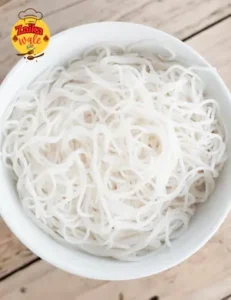
Drain them to a colander and rinse under running water.This keeps the noodles less sticky and helps in the removal of extra starch. Empty thoroughly. Toss the noodles with 1 tsp oil. By doing this, they are kept from becoming stuck. Put aside.

Combine the following ingredients in a small bowl and set aside
- 1 tablespoon rice vinegar or apple cider vinegar; 1¼ tablespoon organic soy sauce (or tamari); 1 tablespoon spicy sauce (or your preferred sauce, if desired
- ½ to 1 tablespoon of optional chili oil
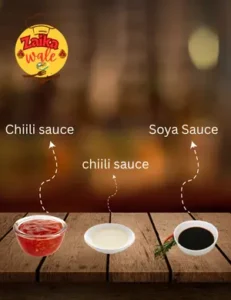
Noodles stir-fried
Add two teaspoons of oil to a wok and heat it over high heat. Drizzle the wok with oil, then, if using, add the chopped ginger and garlic. Just 30 seconds of frying. Add the spring onion whites and optional green chili. Add another 30 seconds of sautéing.
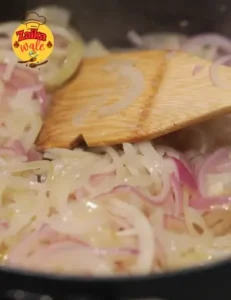
Add onions and fry for 1 minute.
Add the beans, cabbage, carrots, and capsicum. Just fry them for two minutes, or until a pleasant aroma emerges. Don’t overcook the vegetables; they should still be crisp.
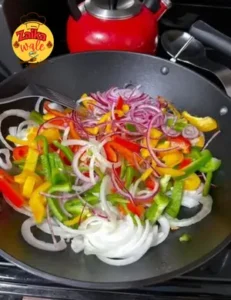
Add the prepared sauce, noodles, and salt.

Give it a good toss and cook for two more minutes. Adjust the sauces and salt according to taste. Add the ground pepper and spring onion leaves.
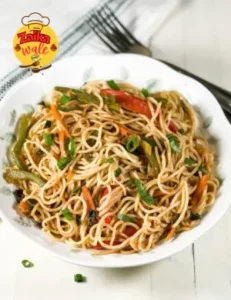
Expert Tips
Prepare the vegetables by thinly chopping them. You might not get it right the first time if you’re a beginner. However, having those thin vegetable slices makes a big difference since, after stir-frying, they will merge in with the noodles. Vegetables might release moisture if they are too chilly.
When preparing noodles, take care not to overcook them. When they are al dente—that is, just done and firm but not soft—drain them after cooking them in plenty of hot boiling water to achieve the desired texture. Rinse them immediately under cold running water.This serves two purposes:
- It prevents them from cooking any longer;
- It eliminates extra starch.
Noodle preparation: To keep the cooked noodles from sticking together, brush them with oil. This is important.
Use a wok or a cast iron pan: A big wok is perfect for making Hakka noodles.Use your wok if you have one made of carbon steel or cast iron. These utensils give your Hakka noodles that smokey aroma.
you can purchane these utensils from given link – https://amzn.to/3IDOFEV
Oil: Here, the amount of oil has an important effect. Please refrain from reducing down on the amount of oil used in my recipe because it doesn’t require as much as the restaurant version. Reduce the portion size but do not cut the oil if you are following a low-oil diet.
Also, I observed that the noodles became dry due to the amount of oil absorbed by the cast iron woks and carbon steel. So, modify the oil as needed.
Over a high heat, stir-fry.
While you stir fry, keep the heat or flame high the whole time. This keeps the vegetables from getting mushy and gives the dish a distinctive smokey flavor.
Because it is done on a high temperature, stir-frying the vegetables and Hakka noodles will take less than four to five minutes. To avoid overcooking and scorching, keep an eye on the pan at all times and continue tossing or mixing with a spatula.
Variations with the desired protein
According to your preferences, adjust the quantity of sauces and seasoning.
- Tofu: Include 1 tsp soy sauce, chili flakes, black pepper, 1/2 tsp vinegar, 1/2 teaspoon garlic powder, and 1/2 teaspoon maple syrup in a bowl. Coat the pressed, extra-firm tofu thoroughly. It can marinate in the refrigerator for a few hours. First, pan-fry until the sauce is dry. Take them out and garnish with them.
- Egg Hakka Noodles: Add two tablespoons of hot oil and four beaten eggs, then scramble. After the eggs are cooked through, transfer them to a bowl. Continue the remainder of the recipe. Reintroduce the noodles and scrambled eggs, and adjust the sauces to your preference. For step-by-step pictures, see this post about egg noodles.
- To make chicken Hakka noodles, whisk together one egg, one teaspoon vinegar, half a tablespoon soy sauce, one-fourth teaspoon black pepper, and one-fourth teaspoon salt. Coat 200 grams of 3/4-inch chicken strips thoroughly with the egg mixture. To 2 tablespoons of hot oil, add the chicken pieces one at a time. Stir-fry over high heat for 3 to 4 minutes, or until cooked through. Cook the remaining egg until it is done. After transferring this to a plate, continue the recipe. Return the noodles and chicken. You can also look at these chicken noodles for step-by-step photos.
Notes –
Vegetables:
Cut them into uniformly thin slices. so that after stir-frying, they cook more quickly and mix well with the noodles. Vegetables that are extremely cold should not be used because they occasionally release moisture into the pan while frying. Don’t cook them in the pan too much. We want them to be crunchy.
Noodles:
Make sure they are cooked others dente, which means just cooked but firm and not too soft, and drain them right away to avoid overcooking. To prevent them from clumping together, thoroughly rinse them with cold water and apply a small amount of oil all over.
Use a wok or cast iron pan
A Chinese wok and high heat are necessary for creating delicious hakka noodles. For the smoky flavors, try using a cast iron or carbon steel wok. On the highest flame, stir-fry.
Oil:
Don’t use too little of it. Without enough of it, you won’t experience the authentic restaurant taste. Feel free to add a little more oil because your carbon steel or cast iron wok absorbs some of it.
Tamari
can be used in place of soy sauce. Use organic or naturally brewed soy sauce.
Green Chilli
You can use green chili or chilli oil for heat.
Stir -fry on a high flame:
Throughout the entire process, maintain the flame high. This keeps the vegetables from becoming overly tender and gives the dish a distinctive smoky flavor.
Nutritional Information- (Per Serving – Approx.)
(Estimation Only)
- Calories: 372
- Fat: 21g
- Carbs: 40g
- Protein: 7g
- Fiber: 4g
- Sodium: 2332mg
- Vitamin C: 69mg


